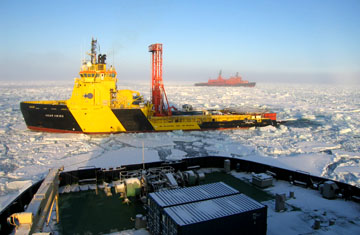 |
Office of Media Relations | |||
News | ||||
|
Climate History Rewritten: Arctic Ice an Early Arrival
Arctic ice formed about 45 million years ago – roughly 14 million years ahead of previous predictions – according to new research published in Nature. An international team of scientists, including Brown geologist Steven Clemens, says this startling evidence shows that glaciers formed in tandem at Earth’s poles, providing important insights into global climate change. PROVIDENCE, R.I. — For the first time, scientists have pulled up prehistoric geologic records from the frigid vault of the Arctic Ocean. One of the findings, evidence of glacial Arctic ice from 45 million years ago, recasts a critical chapter of global climate history. The evidence – pea-sized pebbles locked inside a 430 meter-long sediment core – shows that glaciers formed in the Arctic Ocean about 14 million years earlier than geologists had thought. This means that the immense sheets of ice at the Earth’s poles formed simultaneously, something researchers call “bipolar symmetry” in one of three reports on Arctic ice highlighted on the cover of Nature.  Cold, hard facts Previously, geologists believed glaciers formed in Antarctica long before they appeared in the Arctic. The new evidence clears up this climate mystery and underscores the role that carbon dioxide and other greenhouse gases play in climate change, according to Steven Clemens, associate professor (research) in the Department of Geological Sciences at Brown University and a co-author of the Nature papers. “In the past, scientists thought shifting tectonic plates and changes in ocean circulation patterns in the Southern Hemisphere may have prompted ice to form earlier in Antarctica,” Clemens said. “But there was other data that contradicted this theory. Now much of what we know about the evolution of ice on Earth makes more sense. And the evidence underscores the importance of greenhouse gases as a driver of climate change. If you inject or remove large amounts of carbon in the atmosphere, you get truly global climate change.” Earth shifted from a “greenhouse” climate to an “icehouse” climate roughly 45 million years ago, a dramatic cooling that changed wind patterns, ocean currents and land and ocean temperatures and had a profound impact on plant and animal life. How this change played out in the Arctic, however, has never been decisively documented. That history, written in sediment on the seafloor, sits locked under thick, dense ice. The Arctic Coring Expedition (ACEX), supported by the Integrated Ocean Drilling Program, an international marine research program, successfully penetrated sea ice up to 16 feet thick. This feat took two ice-breakers and a drill ship that hauled up sediment gathered 430 meters below the seafloor along the Lomonsov Ridge, an undersea sliver of the Eurasian continent that broke away and sunk as the Arctic Ocean opened to the Atlantic and Pacific oceans. Clemens was a member of ACEX, led by Kathryn Moran at the University of Rhode Island and Jan Backman at Stockholm University. A paleoceanographer, Clemens was brought in to help analyze the sediment cores, which contained a stunning 54 million years of climate history. Working in a German laboratory, Clemens and other members of the science team studied the samples to determine their physical, mineralogical and biological makeup. The team found:
Clemens said the major finding – evidence of ice-deposited debris 45 million years ago – came in the form of pebbles. Why? Glaciers scrape across the land as they grow, carrying ground rock with them. When glaciers reach the sea, some of that ice shears off and forms icebergs, which shed pebbles as they melt. This evidence of synchronous ice formation in the Arctic and Antarctic in the past may help bolster the evidence of “bipolar symmetry” today. In recent months, scientists have reported rapid melting of the worlds’ ice, from the Antarctic ice sheet to Greenland glaciers. Many scientists believe the shrinking ice is linked to a sharp increase in greenhouse gases. “Bipolar ice forms together and melts together,” Clemens said. “Carbon levels are a huge driver of ice volume and global climate change, at all time scales.” The International Ocean Drilling Program supported the research. The program receives primary funding from the National Science Foundation and Japan’s Ministry of Science, Education, Culture, Sports, Science and Technology. The ACEX platform operations were funded by ECORD, the European Consortium for Ocean Research Drilling, a contributing member of IODP. As an affiliate member, the People’s Republic of China also supported the expedition. ###### Media Relations Home | Top of File | e-Subscribe | Brown Home Page | ||||